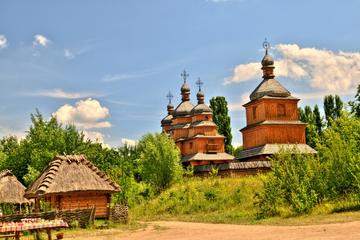
Welcoming the Return of the Sun at the Spring Equinox
by Mara Baudais
I was soaked. The rain and wind had not let up all day. I had a brief respite from both as I boarded the small bus from the Visitor Centre which had taken our group to Newgrange*, a huge megalithic passage tomb. The Visitor Centre acts as a gateway to the Bru na Boinne area, the bend of the Boyne river. In this area lie three Neolithic (4000-2500 BC) Passage Tombs—Newgrange, Dowth and Knowth built over an area of 10 square kilometres—Newgrange, the most famous, Dowth, still unexcavated and Knowth, the largest. Five thousand years ago thirty eight passage tombs were built. The area became known as Bru na Boinne– the cemetery of the Boine. The river, Boine, considered sacred, encircles the area on three sides giving great protection. These structures look out from a black slate glacially created ridge seventy metres higher than the glacial valley through which the Boyne River runs. The warmest part of Ireland, the land boasted of three types of soil: clay, gravel and slate, all fertile. Variety of soil types meant that neither excessive drought nor rain would be a crisis. Six thousand years ago Ireland’s first farmers arrived, cut down trees and planted barley and wheat as the main crop. They also raised sheep, pigs, cattle– much like today’s farmers do. Abundance meant wealth and extra time to devote to the building of great monuments, numerous auxiliary smaller structures, the development of advanced social ritual and probably the development of astronomical ideas and rituals which were tied to astronomy.
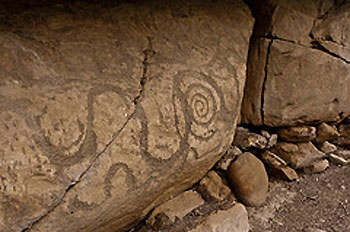 Knowth, specifically, was first established in the early Neolithic six thousand years ago. First settlement is the ancient remains of a wooden/wattle rectangular enclosure with probably a thatched roof. Knowth is one thousand years older than Stonehenge, England and five hundred years older than the Pyramids of Giza in Egypt yet most people have never heard of it. The first use of the tombs was marked by cremated human bones and other material inside and elaborate ceremonies outside.
Knowth, specifically, was first established in the early Neolithic six thousand years ago. First settlement is the ancient remains of a wooden/wattle rectangular enclosure with probably a thatched roof. Knowth is one thousand years older than Stonehenge, England and five hundred years older than the Pyramids of Giza in Egypt yet most people have never heard of it. The first use of the tombs was marked by cremated human bones and other material inside and elaborate ceremonies outside.
There is little evidence of the use of Knowth for the Bronze and Iron Ages, but in the first few centuries AD there is evidence of a new settlement. The mound itself became a defended structure with two dug ditches, like moats. There was only one protected entrance on the south-east and burials were placed around its base.
By AD 800 Knowth became a royal residence of the kingdom of North Brega. Now there were rectangular houses, underground storage areas. In the late twelfth century Anglo-Normans made further fortifications atop the large mound.
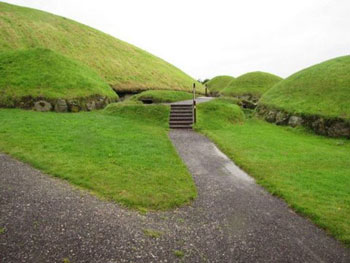 Knowth’s most impressive passage tomb is a great grass-covered mound measuring 80m by 95m. It is encircled by 127 kerbstones, a ring of engraved huge stones. Our word ‘curb’ must come from the same idea of being marked as a boundary. Passage tombs have certain features: being in the shape of an egg, or tumulus; being outlined by kerbstones, having a passageway and also an inner chamber often in the shape of a crude cross.
Knowth’s most impressive passage tomb is a great grass-covered mound measuring 80m by 95m. It is encircled by 127 kerbstones, a ring of engraved huge stones. Our word ‘curb’ must come from the same idea of being marked as a boundary. Passage tombs have certain features: being in the shape of an egg, or tumulus; being outlined by kerbstones, having a passageway and also an inner chamber often in the shape of a crude cross.
One of Knowth’s outstanding features is the huge amount of decorative stone work on the interior passageway stones and on the kerbstones. Knowth holds more than half of the six hundred decorated stones in the Bru na Boinne sites—this being over one quarter of all the megalithic art in Europe.
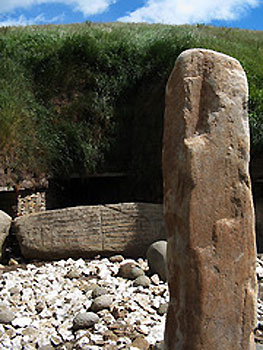 There is evidence that the art developed over many centuries and also ideas were apparently borrowed from Britanny on the continent. A picked cup mark is a feature of Knowth stones and may well represent the idea of a tunnel, a symbol of death. Also, unlike Newgrange, the stone work is developed based on the shape of the rock itself.
There is evidence that the art developed over many centuries and also ideas were apparently borrowed from Britanny on the continent. A picked cup mark is a feature of Knowth stones and may well represent the idea of a tunnel, a symbol of death. Also, unlike Newgrange, the stone work is developed based on the shape of the rock itself.
Under this large mound are two passage tombs, back to back. One faces west, has a 32m passage and a rectangular chamber. The other faces east, has a passage 35m long and ends in a cross shaped chamber. Since the exploration of this passage tomb in l967, there has been speculation and debate between scholars of prehistoric structures and archaeologists as to whether the eastern passage was aligned to the spring equinox, March 20th, and the western passage, aligned to the autumn equinox, September 22nd. Martin Brennan, a scholar, maintains that the chambers may have been aligned to also receive moon beams and that lunar images do appear on some of the inner stones. A large area of cement and metal which is supposedly shoring up part of the entranceway interferes with any proper investigation at this time. It is unknown when any true investigation as to the spring equinox is planned for the near future, especially with a sister passage tomb, Dowth, still needing to be excavated.
 Still burdened with my pull-along bag, my pack sack and umbrella I entered the mound through the entrance which faced east. I slowly made my way along the stoned passageway to the crude cross-shaped chamber, delighting in the subtle light and the energy of the countless many who had also walked as I now did. What will be revealed in the years to come?
Still burdened with my pull-along bag, my pack sack and umbrella I entered the mound through the entrance which faced east. I slowly made my way along the stoned passageway to the crude cross-shaped chamber, delighting in the subtle light and the energy of the countless many who had also walked as I now did. What will be revealed in the years to come?
Beginning from the east a long gravelled pathway, constructed since the mound’s excavation, reached the top of the mound. Buffeted by wind and rain I made my way up to the flattened top of the mound, the wind again turning my umbrella inside out. I looked out over the Bru na Boinne valley, the river and in the distance I could see Newgrange rising out of the distant grassland. Yes, this was another of those moments in Eternity where I could feel my Irish ancestors walking beside me, hear their voices and feel their touch. I, too, will be back.
*Read the author’s ‘Newgrange: Bringing In the Light With the Winter Solstice’ at https://travelthruhistory.com/html/memoirs33.html.

Castle & Curiosities of the Boyne Valley
If You Go:
Knowth, as with the other passage tombs, cannot be directly accessed. You must be on a guided tour that sets off from the Bru na Boinne Visitor Centre by bus. You reach the centre itself by local bus, bicycle or car.
To Get to the Centre:
From Dublin: M1 motorway heading north and turn onto Donore Exit near Drogheda. Travel 6 km to Donore, turn right near the bar and restaurant, travel l km to the Visitor Centre or take a day tour that leaves from Dublin.
From Drogheda: Bus Eireann runs a bus to the Visitor’s Centre. It takes 20 minutes and runs from l0:15am to 4pm.
Other Sites To See:
Newgrange: Another Passage Tomb close to Knowth; associated with the Winter Solstice
Dowth: a lesser of the three Passage Tombs in the same area, yet to be fully excavated
Hill of Tara: 15 km from Newgrange and Knowth; a Passage Tomb known as the ‘Mound of the Hostages’; thought to be where Scotland’s ancient kings were crowned.
About the author:
Mara writes creative non-fiction, travelogues, short philosophical essays and poetry. These are mainly based on traveling and/or a deeply insightful experience. Besides extensively traveling in Europe, she has visited North Africa, Thailand, Nepal, Israel, Turkey, China, Inner Mongolia, Tibet, Sri Lanka after the tsunami, Guatemala, Canada (coast to coast), local areas of the B.C. coast and the Yukon. She has recently returned from a six month trip that stretched from Great Britain to the Black Sea. A photographer, artist, teacher and writer Mara Baudais can be reached at m_baudais@yahoo.ca
Photo credits:
Photographs by Mara Baudais (#1,#3). Also: Megalithic art by fhwrdh (Flickr); Kerbstone by miss libertine (Flickr), Knowth entrance stone by Jule Berlin (Flickr)

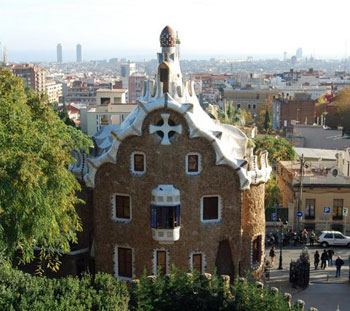
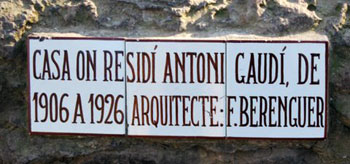 Certainly the buildings were different. Nature, it is said, abhors a straight line. So did Gaudi; the builders, glaziers and carpenters of Barcelona must have hated him. But, we didn’t stop at either of them. We were on our way to the Güell Park, where some of the best of Gaudi’s work is to be seen. Indeed, Gaudi used to live here, in a pink, fairy-tale house which is now the Gaudi Museum.
Certainly the buildings were different. Nature, it is said, abhors a straight line. So did Gaudi; the builders, glaziers and carpenters of Barcelona must have hated him. But, we didn’t stop at either of them. We were on our way to the Güell Park, where some of the best of Gaudi’s work is to be seen. Indeed, Gaudi used to live here, in a pink, fairy-tale house which is now the Gaudi Museum. Güell wanted to build a model village, on the lines of similar villages in England, such as George Cadbury’s Bourneville, in the Midlands. But, Cadbury built his village for workers in his chocolate factory. Güell was much more ambitious. He intended his village for the more affluent and influential people of Barcelona.
Güell wanted to build a model village, on the lines of similar villages in England, such as George Cadbury’s Bourneville, in the Midlands. But, Cadbury built his village for workers in his chocolate factory. Güell was much more ambitious. He intended his village for the more affluent and influential people of Barcelona.
 Gaudi was a devout Catholic, and, in his later years, made the building of the Sagrada Familia his life’s work. However, Barcelona already had a perfectly good Cathedral, and this could have been the reason that no money at all came from the Church. The building was founded solely by public subscription. So, construction progressed very slowly.
Gaudi was a devout Catholic, and, in his later years, made the building of the Sagrada Familia his life’s work. However, Barcelona already had a perfectly good Cathedral, and this could have been the reason that no money at all came from the Church. The building was founded solely by public subscription. So, construction progressed very slowly.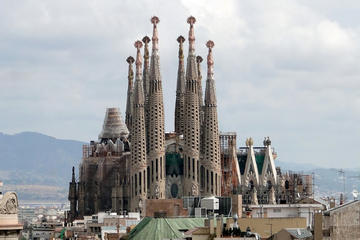
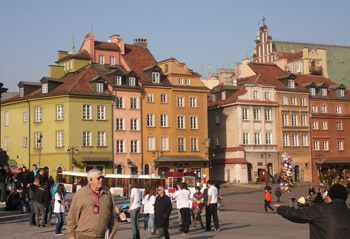

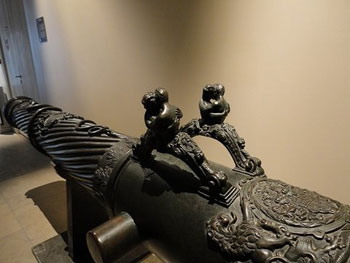

 When we went to Notre Dame, I was delighted to find the Hotel Dieu next door. Why? This was one of the first hospitals built in Europe, in 622 AD. I assumed not many travelers knew it was a hospital and passed by thinking it was a hotel. (It says, “Hotel Dieu” at the entrance and is decorated with international flags.) The present building was not the one from 622 AD, as that original one was burned down in the 1700s. The one we see today was built in 1822. Why is it still called a hotel? In French, it translates to Hostel of God. The first European hospitals during the Middle Ages were managed by the clergy. Their purpose initially was not to treat the sick but to serve as lodging to travelers.
When we went to Notre Dame, I was delighted to find the Hotel Dieu next door. Why? This was one of the first hospitals built in Europe, in 622 AD. I assumed not many travelers knew it was a hospital and passed by thinking it was a hotel. (It says, “Hotel Dieu” at the entrance and is decorated with international flags.) The present building was not the one from 622 AD, as that original one was burned down in the 1700s. The one we see today was built in 1822. Why is it still called a hotel? In French, it translates to Hostel of God. The first European hospitals during the Middle Ages were managed by the clergy. Their purpose initially was not to treat the sick but to serve as lodging to travelers.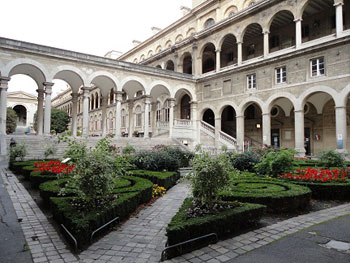 This military museum houses historical artifacts of armour, artillery, and various weapons through French history. Napoleon’s Tomb is situated at one end where you have to leave the museum building to walk to the building’s tomb. We were certainly not military experts nor were we that interested in the museum (as we had planned on just going to Napoleon’s Tomb at the end of the tour), but a couple of amusing gems popped up here. We saw hundreds of knit armor and noticed some really small ones that would fit a child. Did children have to participate in the wars as well? Child labor laws did only appear recently in time! After passing by several cannons on our way to the tomb, we found a cannon with figures of two pairs of kissing couples [TOP PHOTO]. We could not find any history panels to explain its origin. Did the cannon makers have a sense of humor to make love and not war?
This military museum houses historical artifacts of armour, artillery, and various weapons through French history. Napoleon’s Tomb is situated at one end where you have to leave the museum building to walk to the building’s tomb. We were certainly not military experts nor were we that interested in the museum (as we had planned on just going to Napoleon’s Tomb at the end of the tour), but a couple of amusing gems popped up here. We saw hundreds of knit armor and noticed some really small ones that would fit a child. Did children have to participate in the wars as well? Child labor laws did only appear recently in time! After passing by several cannons on our way to the tomb, we found a cannon with figures of two pairs of kissing couples [TOP PHOTO]. We could not find any history panels to explain its origin. Did the cannon makers have a sense of humor to make love and not war?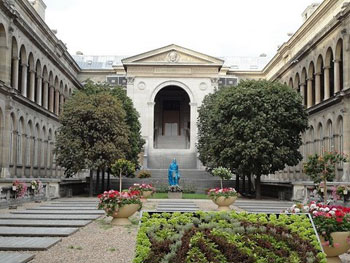 The Rodin Museum houses the famed sculptor’s best works; he requested the government to establish a museum for his artwork. But what you might have known is that Rodin’s mistress, sculptor Camille Claudel, also has a collection here. Rodin and Claudel had a fiery on-and-off relationship; she once accused him of stealing her sculpting ideas. After Rodin left her to return to Rose Beuret, his longtime companion and mother of his son, Claudel spiraled into mental illness, living in a mental institution the last years of her life. Rodin, perhaps having a soft heart and appreciating her talents, requested Claudel’s works to be showcased in his museum.
The Rodin Museum houses the famed sculptor’s best works; he requested the government to establish a museum for his artwork. But what you might have known is that Rodin’s mistress, sculptor Camille Claudel, also has a collection here. Rodin and Claudel had a fiery on-and-off relationship; she once accused him of stealing her sculpting ideas. After Rodin left her to return to Rose Beuret, his longtime companion and mother of his son, Claudel spiraled into mental illness, living in a mental institution the last years of her life. Rodin, perhaps having a soft heart and appreciating her talents, requested Claudel’s works to be showcased in his museum.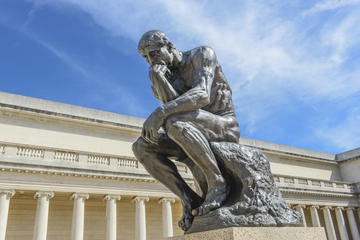
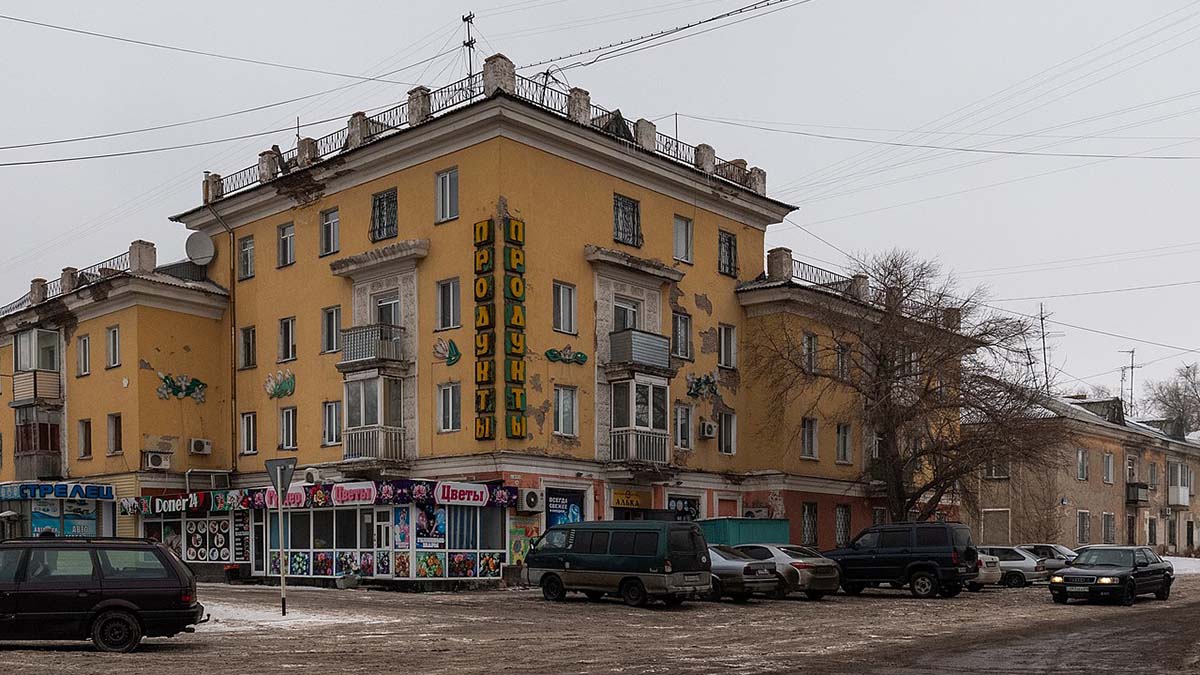
 Before our adoption journey began, I knew next to nothing about Kazakhstan, in part, because until 1991, the country had been swallowed up in that vast entity known as the Soviet Union. So swallowed, it had lost its name, its freedom, much of its language and very nearly, everything about it which made it distinctly Kazakh. Even today, driving the streets of Karaganda, one notices the crouching, well-worn blocks of Soviet style apartment buildings with their Soviet graphics and wonders at the statue of Lenin still posing in the center of town. Still, there are no statues of Stalin, and that is a comfort. After all, it was Stalin who used Karaganda; along with hundreds of other locations in the vast Asian and Siberia steppes, as a full-service slave labor camp, a part of his infamous Gulag system. For years, people were deported to Kazakhstan from places as far away as Germany, Poland, Korea and Japan, put to work in the coal mines still prevalent in the area today and kept behind fences studded with barbed wire, guard towers and patrolled by guard dogs. Alexander Solzhenitsyn; the famous Russian author and Gulag inmate, was set to work not far from Karaganda in Ekibastuz, Kazakhstan. His famous novel, “ One Day in the Life of Ivan Denisovich”, was based on his experiences as a prisoner there.
Before our adoption journey began, I knew next to nothing about Kazakhstan, in part, because until 1991, the country had been swallowed up in that vast entity known as the Soviet Union. So swallowed, it had lost its name, its freedom, much of its language and very nearly, everything about it which made it distinctly Kazakh. Even today, driving the streets of Karaganda, one notices the crouching, well-worn blocks of Soviet style apartment buildings with their Soviet graphics and wonders at the statue of Lenin still posing in the center of town. Still, there are no statues of Stalin, and that is a comfort. After all, it was Stalin who used Karaganda; along with hundreds of other locations in the vast Asian and Siberia steppes, as a full-service slave labor camp, a part of his infamous Gulag system. For years, people were deported to Kazakhstan from places as far away as Germany, Poland, Korea and Japan, put to work in the coal mines still prevalent in the area today and kept behind fences studded with barbed wire, guard towers and patrolled by guard dogs. Alexander Solzhenitsyn; the famous Russian author and Gulag inmate, was set to work not far from Karaganda in Ekibastuz, Kazakhstan. His famous novel, “ One Day in the Life of Ivan Denisovich”, was based on his experiences as a prisoner there.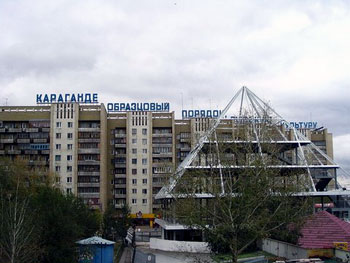 Though economic times are tough, there is a new openness to Karaganda. We met people, from translators to drivers, to those working in the orphanages we visited, who were willing to discuss the painful past of their city, its history of Soviet oppression and to ask us in turn, about our experiences in the west. No attempt was made to hide the shoddiness of much of their surroundings nor were they too proud to ask for help, especially as it pertained to my husband and I buying much needed supplies for our daughter’s orphanage. We found the younger adults and children particularly interested in our lives, our language and why were had come so far to their city. Indeed, it was the older generation of residents who kept their distance and watched us warily when we walked past or played outside with our new daughter. Perhaps a life spent under the thumb of a communist regime had taught them to be more cautious.
Though economic times are tough, there is a new openness to Karaganda. We met people, from translators to drivers, to those working in the orphanages we visited, who were willing to discuss the painful past of their city, its history of Soviet oppression and to ask us in turn, about our experiences in the west. No attempt was made to hide the shoddiness of much of their surroundings nor were they too proud to ask for help, especially as it pertained to my husband and I buying much needed supplies for our daughter’s orphanage. We found the younger adults and children particularly interested in our lives, our language and why were had come so far to their city. Indeed, it was the older generation of residents who kept their distance and watched us warily when we walked past or played outside with our new daughter. Perhaps a life spent under the thumb of a communist regime had taught them to be more cautious.
 For those wishing to visit Karaganda, hotels, restaurants and apartments are available, in various price and quality ranges. While in Karaganda, my husband and I stayed in an apartment whose previous owners had emigrated to Israel, leaving the apartment, along with their clothes, family pictures and clothing, behind. Many permanent residents will move in with relatives and rent their apartments to foreigners willing to pay well and keep their apartments clean. The price for such an apartment is still reasonable and is a great way to get to know the people, places and culture of the city. Karaganda boasts a nice lake and central park in its downtown area which is a welcome change from the traffic of the streets and during the summer, a large circus plays in town which is an event the entire city looks forward to. Karaganda also supports a university and various academic institutions. There are gardens, a water park, a theater and a museum which contains many interesting displays on traditional Kazakh nomadic life which we found very well done. We also enjoyed the many monuments dotting the city, especially the massive memorial dedicated to the Kazakh effort during World War II.
For those wishing to visit Karaganda, hotels, restaurants and apartments are available, in various price and quality ranges. While in Karaganda, my husband and I stayed in an apartment whose previous owners had emigrated to Israel, leaving the apartment, along with their clothes, family pictures and clothing, behind. Many permanent residents will move in with relatives and rent their apartments to foreigners willing to pay well and keep their apartments clean. The price for such an apartment is still reasonable and is a great way to get to know the people, places and culture of the city. Karaganda boasts a nice lake and central park in its downtown area which is a welcome change from the traffic of the streets and during the summer, a large circus plays in town which is an event the entire city looks forward to. Karaganda also supports a university and various academic institutions. There are gardens, a water park, a theater and a museum which contains many interesting displays on traditional Kazakh nomadic life which we found very well done. We also enjoyed the many monuments dotting the city, especially the massive memorial dedicated to the Kazakh effort during World War II.